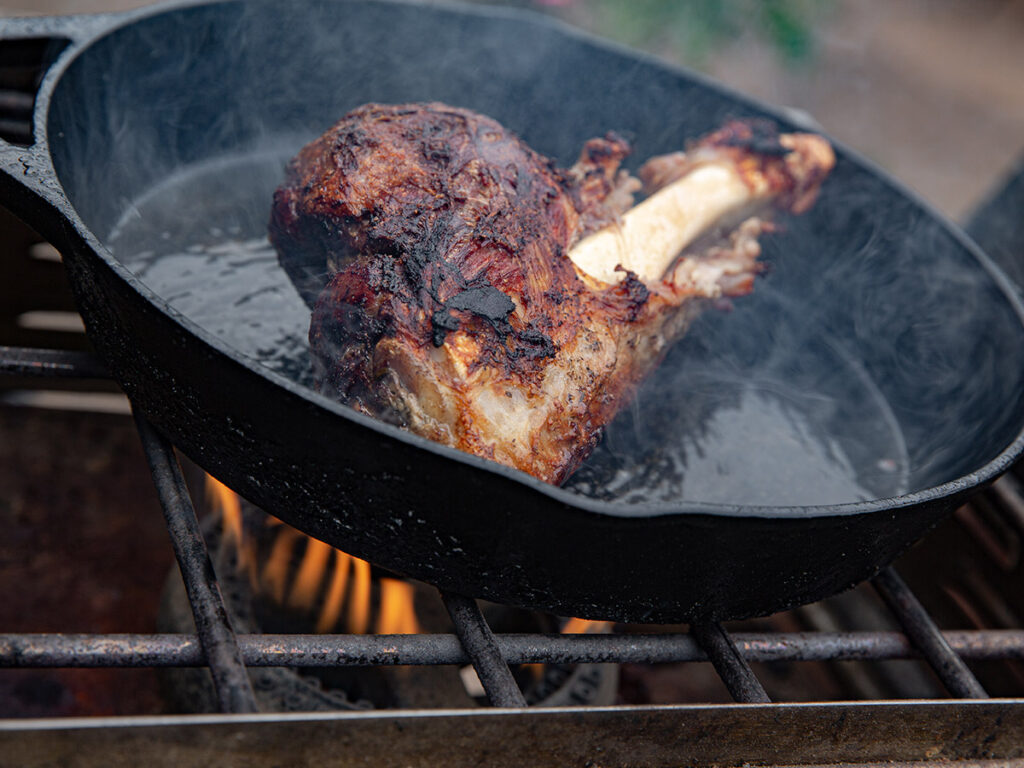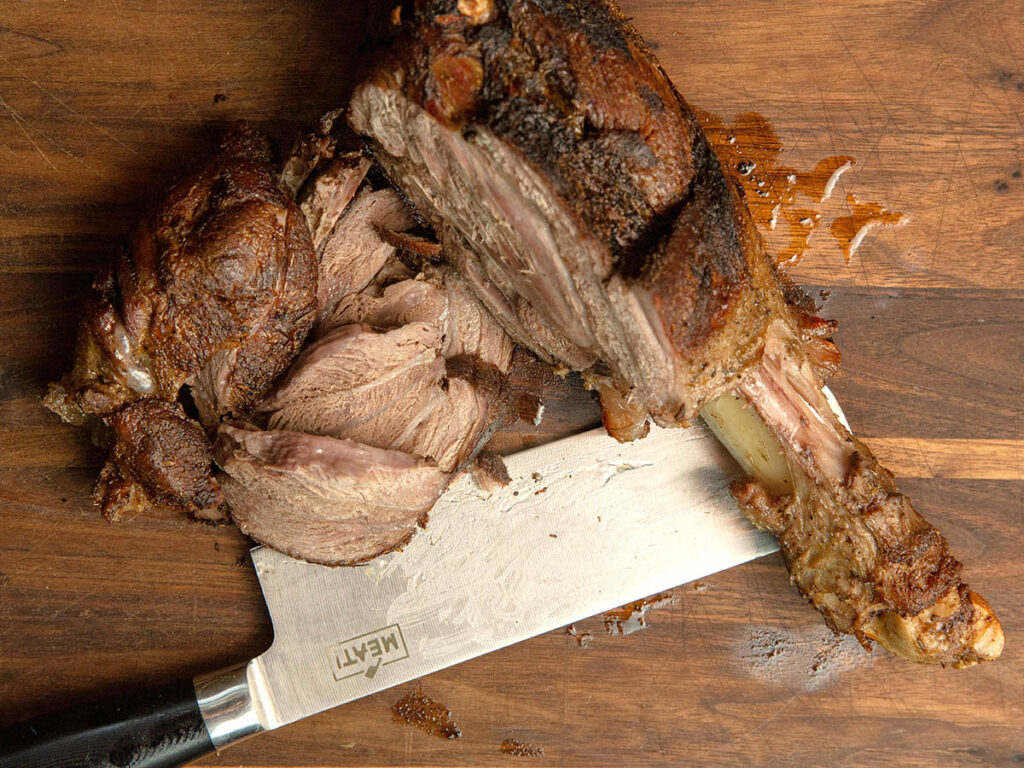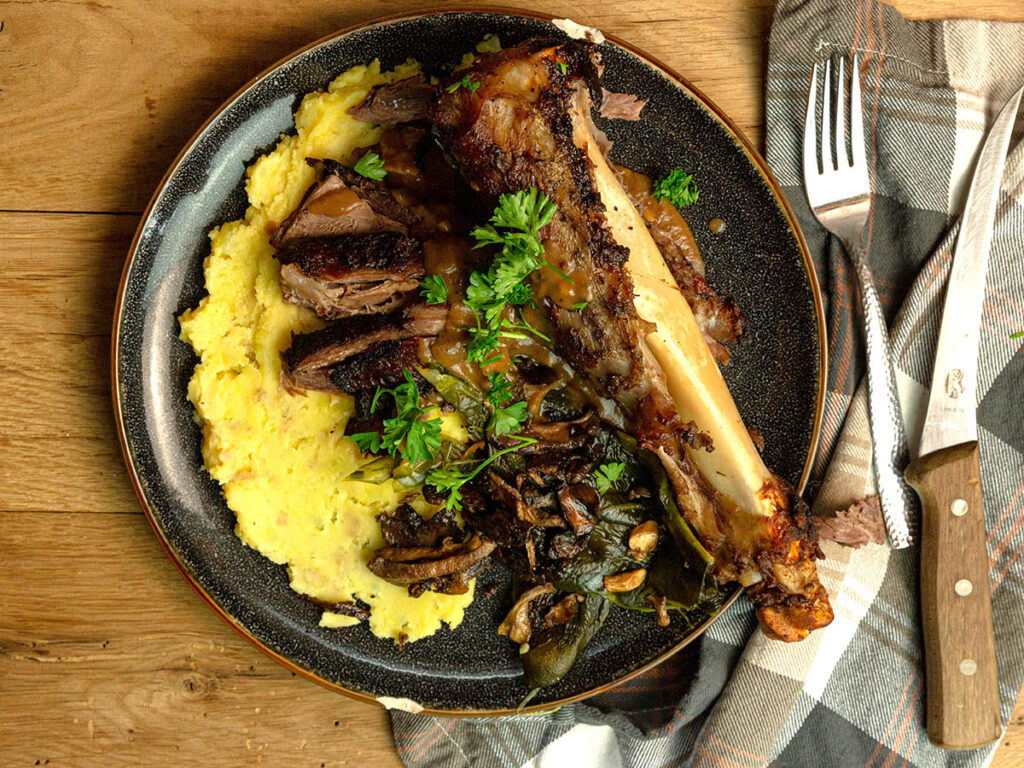At CarnivoreWeb.com, we independently review products and outfitters. However, we may earn a commission when you purchase products through links on our site. Read our affiliate policy. Read about how we test products.
Wild boar can be delicious when cooked right, and this sous vide recipe is proof.
One of the greatest sins perpetrated against the hunting community is the suggestion wild hog tastes anything less than amazing. I’ve watched hunting guides, chaw in lip, take one look at a hog, point to its thick shoulder and proclaim, “It’s got a shield. You don’t want to eat him.” It’s an unwarranted denunciation, especially considering the source speaking would likely burn water.
Here’s something to consider: Domestic, pen-raised hogs are slaughtered when they’re 6 months old (or sooner). The bulk of their diet comes from corn and soybeans, which may be similar to wild hogs, depending on crops available to a sounder. But the biggest difference between your domestic and wild pork is often the maturity of the animal. This concept applies to all wild-versus-domestic meat logic: An animal that has worked to eat its whole life and grown to maturity will have a greater amount of collagen present throughout its muscles. Collagen is a structural protein that supports joints and muscles. When cooked, it’ll toughen before turning to gelatin over a long period of time at lower temperatures, thus tenderizing meat.

This is where a sous vide comes in. A sous vide is a device that regulates a water bath to an exact decimal point of a degree. There are few kitchen devices beyond an oven or open fire that I recommend, but I consider a sous vide essential. Is it trendy? Potentially. Is it a must-have for hunters putting an assortment of critters in the freezer? For the collagen logic mentioned above, absolutely. You may wish to pair a chamber vacuum sealer with a sous vide, as a chamber vac can seal in liquids (think marinades, a bit of wine to flavor and denature proteins). Without a chamber vac, you can work with a Ziploc bag — just be certain to try and remove as much air as possible then firmly seal. If there’s air, you may need to weigh down the bag in the sous vide bath, which is fine — just make sure it’s sealed. You don’t want water getting in.
Another major benefit of a sous vide: You can start it before going to bed and leave it running overnight without the worry that something might burn down or that meat may dry out. You may need to do this for a wild hog shank, as it could take upward of 12 (perhaps even 14 hours) to fully tenderize.
To get specific, the hog shank featured here is from the hindquarter. It’s the whole bone-and-meat package taken from below the femur. The femur is what plays host to all major roasts for big game. Below that is shank. Yes, you can take a shank from the front quarter. There is less meat, and you may want to sous vide for only 8 to 10 hours, but you will produce similar flavor results.

When determining how long to sous vide at 180, please know 8 hours will guarantee you won’t have tough meat. You can err on side of caution and go the full 12, potentially 14. The only thing you may run into when doing so is meat may fall completely off the bone upon removal. Is that a problem? No, just throw through a quick hot skillet and oil sear as if it were a stir-fry. The balance of time in a sous vide, followed by a sear, is the balance of both tenderness and texture. It’s a bit of an art and may take time. But I promise you all the steps here, and wild hogs in general, are worth the effort.

Ingredients (2 Servings)
- Whole shank from rear quarter of mature feral hog
- Kosher salt
- Freshly cracked black pepper
- Whole garlic bulb, crushed and peeled
- 4 sprigs fresh thyme
- 2 sprigs fresh rosemary
- 1 cup dry white wine (a chardonnay is a good choice)
Gravy
- 1 medium onion, finely minced
- 2 tablespoons salted butter
- 2 tablespoons fresh garlic, finely minced
- 11/2 tablespoons white wine vinegar
- 32 ounces beef stock
- Sous vide bag juices
- Sprig of thyme (remove before adding roux)
- Roux: 1/2 cup flour, 1/4 cup sunflower or similar cooking oil, dash of Kitchen Bouquet Browning Sauce
- 8 ounces sliced baby portobello mushrooms
- 4 poblano peppers, roasted, peeled and sliced
Mashed Potatoes
- 1 pound Yukon or russet potatoes, cubed
- Heavy whipping cream
- Salted butter
- Smoked paprika
- Granulated garlic
- Kosher salt
Garnish (Optional)
- Freshly chopped parsley
Steps
- Liberally salt and pepper boar shank. Add to sous vide bag, along with pork shank, garlic, fresh thyme, fresh rosemary, and white wine. Seal and sous vide at 180 for a minimum of 8 hours, likely closer to 12 for mature wild hogs.
- Approximately 2 hours ahead of serving meal, make gravy. Add butter to a medium saucepan and heat on medium. Add finely minced onion, lightly salt and pepper. Stir until onions are slightly seared and soft, add freshly minced garlic and stir for 2 minutes more. Deglaze with white wine vinegar. Add beef stock once deglazed.
- Put fresh sprig of thyme in with beef stock and reduce heat to medium-low. Remove thyme after 1 hour in stock.
- Upon removing shank from sous-vide bag, add all juices to saucepan with beef stock for gravy.
- Around the same time you pull the thyme from the beef stock, pre-heat your oven to 400 degrees F. Rub down poblano peppers with cooking oil and roast for 15-20 minutes until peppers are slightly charred and the skin is loose. Remove peppers and place in a bowl, cover and place in fridge to sweat. After half hour of sweating, remove peppers, seed and take off stems, peel off skin, and slice into strips. Set aside and leave out at room temp.
- While roasting peppers, cut potatoes into approximate 1-inch cubes, put in a large pot and add water, a bit of kosher salt, and place on a burner set to high heat. Bring to a boil. After 5 minutes of boiling, check texture. You want potato cubes to easily mash, which make take upward of 5 more minutes (total of 10 minutes once boiling). Once easily mashed, drain water and set that burner to low. Lightly spice potatoes with kosher salt, paprika, and granulated garlic. Start mashing. Add butter and heavy cream as you wish for desired consistency. Salt to taste. Cover and keep on low-heat burner until ready to serve.
- After appropriate time in sous vide, remove shank (remember to add juices from bag to saucepan with beef stock). Sear shank over high heat. You can do this over an open fire, in a skillet with a bit of oil — the choice is up to you. Sear all sides until browned and slightly crispy. Remove, cover with aluminum foil, and allow to rest while you finish the gravy.
- To finish the gravy, you need to make a roux. In a small saucepan, add flour and cooking oil; mix together thoroughly. Place on a burner set to medium and stir often as roux browns. Watch carefully so not to burn. Once the color of the roux is wet sand, which may take 10 to 15 minutes, remove from burner and add a dash of Browning Sauce. Mix in and then add roux to saucepan with beef stock. Make sure to stand back as it’ll bubble. Stir in roux to thicken beef stock for gravy.
- Rinse mushrooms and add to gravy saucepan. Once mushrooms are soft, turn off heat and add sliced poblano peppers.
- To serve, add mashed potatoes to plate, carve off bits of boar and place overtop potatoes. Dollop gravy over the top and garnish with freshly chopped parsley.

Editor’s Note: This article originally appeared in Carnivore Magazine Issue 9.
Why You Can Trust CARNIVORE
Since its launch, CarnivoreWeb.com has been a trusted authority on hunting, fishing and wild food, delivering expert insight for outdoorsmen who live the field-to-table lifestyle. More than a hunting and fishing site, CarnivoreWeb.com covers the full spectrum of the modern outdoors—from rifles, bows, and fishing gear to cooking, conservation and adventure.
Our contributors are drawn from across the hunting and angling world, including seasoned guides, lifelong hunters, competitive shooters and outdoor writers with decades of field experience. Every review, article and feature is built on firsthand testing, deep research, and an unwavering commitment to accuracy.
Commitment to Journalistic Principles
At CarnivoreWeb.com, upholding journalistic integrity is our top priority. We follow strict editorial standards to ensure all content is accurate, transparent, and unbiased. Our editors and writers operate independently, free from outside influence, advertisers or stakeholders. We adhere to established journalistic codes of ethics, holding ourselves accountable for the information we publish, correcting errors when they occur and disclosing any potential conflicts of interest.
This commitment ensures that our readers can trust CarnivoreWeb.com to provide reliable, honest coverage that helps them make informed decisions—whether selecting gear, honing outdoor skills or preparing wild game.
Find out more about our Editorial Standards and Evaluation Process


